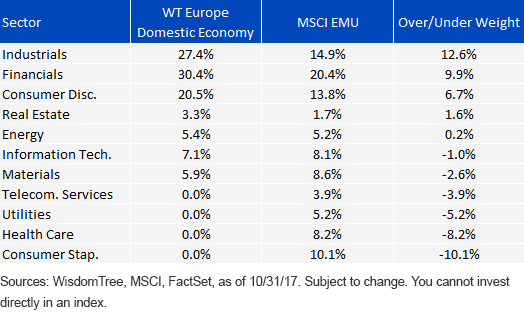How To Position For Cyclical Recovery In Europe
A big storyline heading into 2018 is whether this year’s strong performance in European equities will continue in the year to come or if it was merely a flash in the pan for an otherwise dysfunctional economy.
While there are potential headwinds for the recovery (namely, ever-present political risks and the challenge of negative interest rates for a banking system still confronting issues around deleveraging balance sheets while managing portfolios of nonperforming loans), there is also an argument that these risks are sufficiently priced in and this European rally is just getting underway.
For over 11 years, WisdomTree pioneered a proprietary, self-indexing approach to tap into markets in unique ways using a consistent, rules-based manner. A review of the WisdomTree Europe Domestic Economy Index’s construction provides interesting insights for how it benefited from the strong economic growth environment in 2017 and how it is positioned currently should this rally continue into 2018.
On Cyclical Growth
The WisdomTree Europe Domestic Economy Index is designed to represent a pure play on the more local dynamics of the eurozone economy. Many investors often are forced into small-cap companies to avoid large-cap mega-nationals that often are driven by global sentiment, China and the emerging markets. The WisdomTree Europe Domestic Economy Index was designed to be all cap, but it targets sector exposures that benefit from more cyclical changes in growth.
With European growth turning more positive in 2017, the Index’s 31.7% year-to-date returns have outpaced the MSCI EMU Index by over 400 basis points (bps).1 How was this outperformance achieved?
The Index’s methodology has four ways to target eurozone companies most sensitive to the local economy’s growth:
- Sectors: Exclude defensive sectors2
- Size: Use a market cap minimum of $1 billion
- Geographic Revenues: Derive more than 50% of revenue from within the eurozone
- Weighting: Employ a modified market cap weighting to increase weight to companies that have the highest correlation to the European Commission Economic Sentiment Indicator
From a sector perspective, these screens and this weighting methodology result in an Index that has no weight in Telecoms, Utilities, Health Care or Consumer Staples, with notable over-weights in the more cyclically oriented Industrials, Financials, and Consumer Discretionary sectors.
(Click on image to enlarge)

The Index rebalances on an annual basis to include only those companies with sufficient domestic revenues and reweights companies to increase the sensitivity of stocks to the local economic prospects using an indicator we see as a forward-looking view of economic momentum. The European recovery at present has benefited from the tailwinds of global growth, but should the mature recovery in the U.S. lose steam or the emerging market growth engine pause, a domestically focused Index should be less impacted by such external factors.
Room to Run: Financials
No market is without its risks, and one risk that is often highlighted for the eurozone is the Financials sector. Financials constitute a 30% weight in the WisdomTree Index, which is a 10% over-weight to the MSCI EMU Index. It is no secret that the European Financials sector has had a more difficult time recovering from the depths of the financial crisis than other sectors, and their recovery has paled in comparison to U.S Financials.
(Click on image to enlarge)

Historical Performance and Valuations: Over the past decade, in terms of price appreciation, the MSCI EMU Financials sector has outperformed only Utilities and has far from recovered to pre-crisis levels as it has returned -42%. Simply a reversion to prior levels would spell great returns ahead. From a valuation perspective, this underperformance has helped result in the sector’s dividend yield of 3.60% and a price-to-earnings multiple of 15.4x, both meaningful discounts from the 2.79% and 18.5x for the broad index.3At a time when investors are keen on mitigating valuation risks in their global portfolios, this discount could be of interest.
Yield Curve and Loan Growth: The topic of yield curve flattening4 has become ubiquitous with U.S. investors over the past several weeks. In the above graph of the German bund 2s–10s spread, we can see that the spread shows little sign of narrowing, and at 107 bps, flattening is of much less concern than for the U.S., where the spread has narrowed to less than 60 bps.
While the steepness of the yield curve is an important indicator of the economy’s health, it is of utmost importance to analysts of bank profitability. A major source of bank profits is borrowing cheaply at the front end of the yield curve, and then lending those funds at the long end of the yield curve at a higher rate. As loan growth continues to pick up steam, as it has this year, and if there is any upward pressure on longer-dated bund yields as the European Central Bank’s tapering of asset purchases begins next year, banks will be likely to profit.
Conclusion
The WisdomTree Europe Domestic Economy Index was constructed with exactly the type of strong-growth economic environment of 2017 in mind. And there is a case to be made for similar conditions in 2018: monetary policy should keep financial conditions accommodative, inflation appears under control and there is plenty of evidence that the eurozone still has a ways to go in its recovery, not least of which for the Financials sector. For investors that conclude their year-end review with a bullish outlook on European equities, the WisdomTree Europe Domestic Economy Fund (EDOM), which tracks the WisdomTree Europe Domestic Economy Index, may prove an opportune means of accessing the market’s growth.
Disclaimer: Investors should carefully consider the investment objectives, risks, charges and expenses of the Funds before investing. U.S. investors only: To obtain a prospectus containing this ...
more


